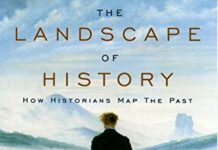
Ebook Info
- Published: 2004
- Number of pages: 208 pages
- Format: PDF
- File Size: 1.15 MB
- Authors: John Lewis Gaddis
Description
What is history and why should we study it? Is there such a thing as historical truth? Is history a science? One of the most accomplished historians at work today, John Lewis Gaddis, answers these and other questions in this short, witty, and humane book. The Landscape of History provides a searching look at the historian’s craft, as well as a strong argument for why a historical consciousness should matter to us today.Gaddis points out that while the historical method is more sophisticated than most historians realize, it doesn’t require unintelligible prose to explain. Like cartographers mapping landscapes, historians represent what they can never replicate. In doing so, they combine the techniques of artists, geologists, paleontologists, and evolutionary biologists. Their approaches parallel, in intriguing ways, the new sciences of chaos, complexity, and criticality. They don’t much resemble what happens in the social sciences, where the pursuit of independent variables functioning with static systems seems increasingly divorced from the world as we know it. So who’s really being scientific and who isn’t? This question too is one Gaddis explores, in ways that are certain to spark interdisciplinary controversy.Written in the tradition of Marc Bloch and E.H. Carr, The Landscape of History is at once an engaging introduction to the historical method for beginners, a powerful reaffirmation of it for practitioners, a startling challenge to social scientists, and an effective skewering of post-modernist claims that we can’t know anything at all about the past. It will be essential reading for anyone who reads, writes, teaches, or cares about history.
User’s Reviews
Editorial Reviews: Review “Will… never allow either the reader of history or the writer of it to think about the past in quite the same way as before.”–The New York Times”A masterful statement on the historical method…. Gaddis’ characterization of the social sciences will surely spark debate even as it illuminates important intellectual connections between the disciplines. Delightfully readable, the book is a grand celebration of the pursuit of knowledge.”–Foreign Affairs”A bold and challenging book, unafraid of inviting controversy. It provides a strong statement for our time of both the limits and the value of the historical enterprise.”–The New York Times Book Review”A real tour de force: a delight to read, and a light-hearted celebration of the odd, ‘fractal’ patterns that intellectual and other forms of human and natural history exhibit.”–William H. McNeill”Turns the old argument over science and history upside down.”–The Washington Post Book World”Never before have I come across a book that so illuminated the craft of the historian.”–Michael Pakenham, The Baltimore Sun”This is another of those books that rewards the effort it requires. Besides providing invaluable insights into how the historian goes about his business, it teaches–like all really good books–of life beyond its boundaries.”–Colin Walters, Washington Times About the Author John Lewis Gaddis is the Robert A. Lovett Professor of Military and Naval History at Yale University. A leading authority on Cold War history, his books include We Now Know, The Long Peace, and Strategies of Containment. He lives in New Haven, Connecticut.
Reviews from Amazon users which were colected at the time this book was published on the website:
⭐John Lewis Gaddis’ The Landscape of History is a scholarly yet very approachable work that successfully attempts to pick up the mantel of the famous scholars of historiography, specifically Marc Bloch and E. H. Carr. Gaddis’ purpose is to encourage students and historians not only to reexamine the theories of Bloch and Carr in a more modern light, but also scrutinize the methodology that historians use, and more often than not, recoil from making explicit. Gaddis, in a veiled manner does refute some of the assumptions of postmodernism, primarily the extremist view that historians are unable to make conclusions about the past. Gaddis is content with inundating his work with metaphors, some of which span chapters to relate and clarify complex ideas and arguments to the reader since he claims that “we need all the help we can get” (pg 128). Gaddis, masterfully using this powerful tool, arrives at a concept of historical consciousness which he argues helps to establish human identity. In the course of this argument Gaddis explains how historians “achieve [this] state” (pg 129) through their manipulations of time and space, the mechanisms of structure and progress, and causation, contingency, and counterfactuals. He claims that the methodology that emerges, although long since said to be closer to the realm of the social science, actually uses methods and techniques more similar to paleontology, geology, and evolutionary biology since both require thought experiments.One of Gaddis’ achievements is his ability to convey complicated ideas in a crisp, persuasive, and well-supported fashion. His primary tool is the use of extended metaphors, the most important being the painting The Wanderer above a Sea of Fog by Caspar David Friedrich, comparisons to sciences such as paleontology, and the length of Britain’s coastline. Gaddis’ exploration of metaphor of The Wanderer above a Sea of Fog spans his carefully unfolding arguments from beginning to end and each subsequent interpretation is added to by the next, providing a vast framework. These metaphors provide a point of reference for the reader and a visual embodiment of Gaddis’ arguments. It encourages active participation by the reader in the argument and the layered interpretation exemplifies the complexity of his arguments and the complexities the historian faces in general.Gaddis argues that people cannot apply the `scientific method’ to history, since historical events have already happened the causes cannot be proven with a physical experiment. But not all sciences use physical experimentation either. Paleography examines the remains and postulates from fossils that are millions of years ago. History and many sciences “start [s] with surviving structures;” the geologist studies an ancient formation, the historian his sources (pg 41). The conclusions are proven by thought experiments; however, the deductions made must be “tethered to and disciplined by their sources.” Gaddis does not clearly state if history is a science, but declares that the “distinction would lie along the line separating actual replicability… from the virtual replicability that’s associated with thought experiments” (pg 43). He is not skirting the issue for much it to be gained “by comparing what they do to what happens in other fields,” namely, to illustrate facets of the historian’s own methodology. This answer relates back to Gaddis’ purpose, to argue that historians need to make their methodological approaches clear for “methodological innocence leads to methodological vulnerability” especially from the extremist critiques of the postmodernist (pg 51). Just as metaphors cannot convey the complexity in its entirety yet yield important benefits, comparisons to science allows the historian to examine their methodological methods.A critic of The Landscape of History probably would argue that the well-read student or historian already puts into practice, sometimes without knowing it, most of Gaddis’ conclusions about methodology. However, Gaddis’ purpose is not to belabor the obvious but rather to argue that historians need to make “their methods more explicit” (pg XI). This book rather, makes a point to examine these unconscious workings that once pointed out to us are often obvious. Like many historians and students Gaddis’ admits that he also has questioned the benefit of history, a study that he has devoted his life to, and partially because of his unease he decided to write this book to reestablish in his own mind the importance of history (pg x). He concludes with the following powerful statements of the purpose of history which his metaphors slowly revealed: “by breathing life into whatever remains from another time… we thereby assure it a kind of permanence” (pg 140), the study “helps establish human identity” (pg 147), and by “learning about the past liberates the learner from oppressions earlier constructions of the past have imposed upon them” (pg 146). The most remarkable part of the book, and unfortunately the briefest, occurs on the last few pages where Gaddis argues that the “single most important thing any historian has to do…. is to teach” (pg 149). Gaddis’ The Landscape of History is a fascinating and illuminating read for both the student and the historian.
⭐The Landscape of History is based on the series of lectures presented by John Lewis Gaddis during his Eastman Visiting Professorship at Oxford University. In them, he presents his thoughts on how and why historians pursue their profession.ScopeThe historian is a traveler in time and space with the freedom to (1) select the specific times and places, (2) simultaneously examine events that were originally separated in time and/or space, and (3) adjust the scale of his research from the micro to the macro in time, space, and events.History as Cartography?The historian creates a map, a representation of history, much as a cartographer creates a map that represents a portion of the earth’s surface. Neither representation can capture all the detail of the original. Each must focus on a subset of the original chosen to illustrate specific features.History as Science?History can be thought of as a form of remote sensing. It employs thought experiments similar to those in such non-experimental sciences as geology, astronomy and evolutionary biology. These sciences, like history, are not replicable. Perhaps they are a form of history.History as Social Science?The social sciences (economics, sociology, some might include psychology) are intently focused these days on developing predictive models and identifying independent variables. Physics-envy, Gaddis calls it. The trouble is that there really are no independent variables. The Fed can change interest rates, but they do that in response to inflation. Inflation depends on the growth of the money supply which, in turn, responds to changes in interest rates. So, where is the independent variable? Rather than taking the reductionist approach of the social sciences, historians take an ecological approach, viewing events as part of an interacting system. Their goal is to understand what happened in the past, why and how it was significant, but not to predict the future.Narrative versus ModelsHistorians present their results in the form of narratives rather than models, and, as a result, their work is accessible to a much wider audience.Biography is a particularly difficult form of history. To be successful, the biographer must see the world and history through the eyes and mind of his subject and chronicle not only what the subject did but why. But then, having mind-melded with the subject, the biographer must break the bond in order to provide an objective assessment of the subject.The historian develops a representation of history, with the passage of time, may become the perceived historical reality. This creates a special responsibility. Moral judgments are an integral part of writing history. There is a currently popular “post-modern” urge among some academics to write purely factually, non-judgmentally, but how can one not judge Hitler, Lenin and Stalin, Mao, Pol Pot, or bin Laden? The difficulty is to judge in a manner that convinces both professional historians and non-professionals.As a leading historian of the Cold War, Gaddis confronted one problem most historians experience only in their nightmares: The subjects of his research (many of whom were or are still alive) could and did confront him and challenge his narratives. Perhaps he envies the medievalists who are only confronted by Banquo’s ghost.ConclusionsGaddis ends on an optimistic note: The sources of oppression are lodged in time and are not independent of time. We can escape then. But that is not to say that new sources will not arise.Historians’ purpose is to help define the optimal balance within ourselves and within society between oppression and liberation. Here oppression and liberation are not limited to the conflict between the individual and society or government. They include conflicts within ourselves. Gaddis makes the interesting point that we need balance between oppression and liberation, not the elimination of oppression and maximization of liberation. Some (mild) forms of oppression are essential to stimulate growth, to interact constructively with society, to cope with life. The goal is to achieve an optimal balance in order to grow, to mature, to understand ourselves in relation to society.Reviewer’s CommentsThe Landscape of History was both interesting and fun to read. Gaddis has retained much of the flavor of his original lecture series: The conversational tone and injections of subtle humor. I’ve read and reviewed several of his other books. I think this one gave me some insights into his methodology and work that I didn’t get from his major works. I particularly enjoyed his comments on biography and will keep them in mind as I read his biography of George Kennan and contrast it with Kennan’s autobiography.
⭐Firstly, I am not a historian. I didn’t do history beyond Key Stage 3 at school as I had to chose between it and Geography as a subject to study as GCSE. I chose Geography and went on to achieve a First Class degree in this subject. But I have always been interested in History and most of my reading since graduating many years ago is on this subject.I found this book listed on the website www.listmuse.com under ‘The 100 Best History Books’ and it didn’t disappoint.’The Landscape of History’ is a collection of lectures prepared by Gaddis which discusses the methods used by historians as they conduct their research, particularly in comparison to the methods used by the social and physical sciences. Gaddis shows how historians apply methods similar to those employed by the historical sciences such as geology, astronomy and palaeontology. Gaddis suggests that social sciences such as sociology, economics and political sciences have gradually adopted a scientific approach which is outdated and which physical scientists have discarded and finds evidence that historians apply methods similar to physical scientists.It seems self evident in hindsight but Gaddis also points out that historians can only ever incompletely represent the past. To represent the past accurately would be to recreate the past which, firstly is impossible, but also is not informative. Just as a cartographers map of the world is selective in what it represents. They also do not create a map of the world which is equal in size to the world, as this would be recreating the world and not a map. So historians can only ever partially represent the past. And this means that histories of the past are always subject to reinterpretation in light of new findings and different perspectives. Personally when I choose a book I look for the most update book on a subject or read a review by an expert in the field to assure myself that the content is factually correct and the interpretations are accurate. Really this misses the point. Facts are liable to change. Interpretations need to be reappraised and updated. What Gaddis does encourage is that readers become historically literate. As it is only with a robust understanding of the past that we can make better decisions in the future.What Gaddis fails to say is that Historians have to write good histories. I have read some history books which read like great page turners and I have read others that read like swimming in thick syrup.Reading this book also gave me a perspective on my own profession which I will not elaborate further in this review.My partner reads mostly fiction. The reason she says is to understand the human condition. I personally think reading history achieves this goal too while also understanding where we came from and perhaps where we might be going. This book reaffirmed the reasons why I read history.If you are a recently history graduate you might already be familiar with this book. If you are not, I suggest you read this book.
⭐Gaddis applies to the writing of history what he’s applied to the Cold War for so long – an academic, approachable and ultimately readable book that expands the readers mind
⭐Già detto tutto nel titolo. Essenziale lettura per chiunque! Anche gli esperti delle discipline più distanti possono trovarvi materiale di riflessione.maybe i was just expecting something which i didn’t find in the book. well, i am happy still after reading it.
⭐これは非常に面白い作品です。著者は有名な冷戦を専門とする国際関係史の専門家です。(George F. Kennan: An American Life
⭐) そして中身は著者のoxford滞在中の講演を原型としています。というわけで、歴史の方法論というドライなテーマを扱いながらも、非常に読みやすい作品に仕上がっています。著者が自分の方法論を惜しげもなく本書の中で縦横無尽に展開しています。それぞれ各章のタイトルを見ていただくと、「time and space」、「structure and process」、「the interdependency of variables」、「causation , contingency and counterfactuals」等、興味深いテーマが目白押しです。以上のような角度から歴史現象と事実をどうとらえ再構築(representation)していくかが見事に説明されています。著者が強烈に意識するのは、科学としての歴史学です。これはアメリカでの社会科学がもつ歴史的な志向なのです。 ソヴィエト研究ですらこの論点を強烈に意識しているのです。{Know Your Enemy: The Rise and Fall of America’s Soviet Experts
⭐) 実験による論証ができないという限界を持つ歴史学ですが、そのような限界を持つこの学問がどうして「科学」足りうるかが、新しく変貌しつつある現代の「科学」観をベースとして、ある意味では「居直り」ともいうべき議論が展開されます。実験ができないという限界を抱えるフィールドは自然科学にもたくさんあるのです。もう一つ強烈に著者に意識されているのが、隣接学問、「国際関係論」「国際政治学」との比較です。「国際関係史」と違い、経済学の影響を受け、科学的な学問の「体裁」と法則の抽出そして予測への強烈な志向を持つ「国際政治学」のお粗末な現状がその方法論上の潜む陥穽から解き明かされていきます。独立変数と従属変数という一見「科学的に」見える作業図式を単純に社会現象にあてはめた際に陥りやすい袋小路が、理論並びにそのもたらした結果の観点から、大胆に明らかにされます。ここでは10年以上前にもてはやされた「複雑系」の議論も大幅に援用されています。ところでこの表紙は、david casper friedlichの有名な絵です。この絵をめぐる解釈からこの作品はスタートします。
⭐
Keywords
Free Download The Landscape of History: How Historians Map the Past 1st Edition in PDF format
The Landscape of History: How Historians Map the Past 1st Edition PDF Free Download
Download The Landscape of History: How Historians Map the Past 1st Edition 2004 PDF Free
The Landscape of History: How Historians Map the Past 1st Edition 2004 PDF Free Download
Download The Landscape of History: How Historians Map the Past 1st Edition PDF
Free Download Ebook The Landscape of History: How Historians Map the Past 1st Edition



